#Desoxyn Prescription
Text
i was finally able to get meds 🤟🏻
#now to see if it works lmao#my final prescription was generic extended relase adderall. nooo idea how we got there from ritalin but ok#i literally do not care i would just like to be on some kind of medication so that i can think clearly#they could prescribe me meth and i would say thank you#(in some rare cases doctors do prescribe literal meth under the name desoxyn. fun fact of the day)#anyway now i've gotta decide if i want to be Social™ today. i was supposed to go to a meetup thing today#but idk. i'm not feeling it. these last few days have been too much lmao#m.txt
6 notes
·
View notes
Text
DRUGS COST MONEY (MARK LEWISOHN, DRUG BUDDY)
I'm late, but I'm here, and this is something I've thought about since I read Tune In the first time.
First of all, Lewisohn's definition and description of what Preludin was is wildly underplayed and misleading, so I have to just get out a few quick Preludin facts. They're helpful.
Lewisohn:
Preludin was an appetite suppressant, an anorectic drug introduced into West German society in 1954, when commercial pressures were making women become more image-conscious. Users maintained an appetite but quickly felt full when eating, and the reduced intake brought about weight loss. Preludin’s primary ingredient, phenmetrazine, was not an amphetamine but an upper, giving the user a euphoric buzz. It was soon sold internationally and used recreationally, and though available in Germany only with a doctor’s prescription...
- “Tune In” - Chapter 19; Piedels on Prellies
(Oh, those women and their obsession with weight.)
I know Lewisohn's not a chemist and I don't expect him to have done extensive study before writing “not an amphetamine but an upper”—which, first of all is just a weird, grade school sounding statement about any stimulant in general that no scientist would ever say or write—but also he makes it sound like it's a fizzy little pill that gives you the sillies.
But definitely not an amphetamine or anything bad like that.
Look, even Wikipedia says right at the top, “[i]ts structure incorporates the backbone of amphetamine,” and although I didn't spend more than a few seconds there, I saw it because it came up first in the search like Wikipedia always does. Just saying it's basically impossible to miss.
And whether he was trying to hide the ball or not, since he wrote so much about them I am going to quickly set the "not amphetamine" record straight before I go on.
“Methamphetamine hydrochloride (Desoxyn) and phenmetrazine hydrochloride (Preludin) are two variants of the amphetamine structure.”
- “Amphetamine Abuse”, Sidney Cohen, MD, JAMA
“The experience in Sweden seems to indicate that phenmetrazine (e.g. Preludin) has the highest potency, and the greatest risk of psycho-toxic, acute and chronic effects (Rylander 1966). Amphetamines and methylphenidate seem to show less dependence-producing and psycho-toxic effects than phenmetrazine.”
- (United Nations Bulletin; Vol XX, No. 2)
Basically, Preludin was synthesized by taking an amphetamine skeleton and boosting tf out of it by adding a very common sort of chemical scaffolding to it called a morpholine ring, allowing them to tweak it by sticking on a nitrogen group. But morpholine rings by themselves also increase potency and usually bioavailability.
So in the narrowest technical sense, Phenmetrazine (Preludin) is classified as a morpholine instead of an amphetamine, but in every way it is an amphetamine on speed. (And every description of it anywhere says so right up front.) It was Amphetamine Plus. The little added synthetic kicker the pharmaceutical company figured out how to attach to the amphetamine made it stronger—gave it the Preludin "kick"—made the high feel better in general (according to all this crap I spent way too much time reading) and also made it way more addictive. It increased dopamine and norepinephrine reuptake, and the compound itself displayed “some entactogen properties more similar to MDMA." It made Preludin far more psychoactive than straight amphetamines. Made smells stronger, sensations more intense, and made you horny and "increased performance." It was taken off the market in 1980 because it was so hyper-addictive and the “psycho-toxicity” was so extreme. People reported doing things they barely remembered, including to a kind of freakish degree, like a lot of users committing crimes for the very first time in their lives. And so the company tried to replace it with a similar drug called Prelu-2, which is apparently still available but also almost never prescribed because even that was excessively addictive compared to non-boosted amphetamines.
And also, it made you feel body odors?
"...perfumes and flowers get a stronger smell, and body odours are felt more strongly than under normal conditions."
- (United Nations Bulletin; Vol XX, No. 2)
What are normal conditions? Maybe my normal conditions are different from everyone else's because I don't normally feel body odors?? But tbh I would literally try this drug just to see if I could.
Okay.
So... John was feeling some serious body odors because my man took a lot of them. Usually with lots of booze.
And apparently they made him more awesome.

George spoke graphically of how they would be “frothing at the mouth … we used to be up there foaming, stomping away.” John, as always, dived straight in, wholeheartedly grabbing another new experience with an open mouth and no thought of tomorrow. The Beatles called them “pep pills”—the commonly used British term of the period—and also “Prellies.”
...Two pills a night were more than enough for most but John frequently took four or five, and in conjunction with hour after hour of booze he became wired, a high-speed gabbling blur of talent, torment and hilarity.
- “Tune In” - Chapter 19; Piedels on Prellies
Yeah, he sounds like a blast. Good thing you got a quote there, my guy. I'm sure the first description that would’ve come to his roommates’ minds would be “hilarity.” Or second, after “hero.” (Sorry, I don't want to be hard on John. I have a lot of bandwidth and patience for drug indulgences, especially in a situation like this, but Lewisohn is unbelievable.)
Ruth Lallemannd, a St. Pauli barmaid who knew the Beatles from 1960, recalls an occasion when “They crushed ten Prellies to powder, put them in a bottle of Cola and shared it between them. They were always wound up.”
Drugs cost money
Amazingly enough though, these prescription-only pills didn't just magically get from people with nice doctors to John’s hands. Someone sold them to someone else and they ended up with “the toilet lady,” Tante Rosa, who sold them.
They looked like little white sweets … but these were no mint drops.
- Chapter 19
So cute!
Preludin small-print advised against its being taken less than six hours before bedtime, in case of sleep disorders.
- Chapter 19
So if Lewisohn is reading the small print of a drug that was discontinued 44 years ago he did not miss the Wikipedia page and must know that “not an amphetamine but an upper” is wildly misleading. Technically true in the chemical classification sense, but not in the medical or pharmacological sense. And true in the same way that “fentanyl isn't morphine” is true.
But that's not my point.
My point is that these “little white sweets” were strong, had wild “psycho-toxic” effects, John took a lot of them, and they weren't free.
Because drugs cost money.
Paul slept fine on just the one pill, John and George didn’t. George would recall “lying in bed, sweating from Preludin, thinking, ‘Why aren’t I sleeping?’ ” John simply took more: “You could work almost endlessly until the pill wore off, then you’d have to have another … You’d have two hours’ sleep and wake up to take a pill and get on stage, and it would go on and on and on. When you didn’t even get a day off you’d begin to go out of your mind with tiredness.”
Or, put another way, John was “a high-speed gabbling blur of talent, torment and hilarity.” And Paul did uncool stuff like sleeping.
Also, what in the...
Tony, George, Paul, John and Pete, along with Rosi and perhaps some stray females, would stagger wearily and noisily up three long flights of wooden stairs...
“Stray females”??? Is he talking about cats? Don't call human beings “strays,” you self-important oddity.
THE GROWNUP
John was never much into paying for stuff. Like rent, for instance. But that's what friends are for.
John was blessed with a particular talent for frittering away his funds (the council grant designed to provide his working materials) and was rarely in a position to pay [rent]. As Rod remembers, “During the week I’d go and have a pint with him and he’d always have money for a beer, but when it came to the day to pay the rent he was always hard up. ‘Could I owe it to you?’ ‘Would you like this jacket?’ One time he paid me with a Mounties-type Canadian jacket he’d probably nicked from someone else.”
- “Tune In” - Chapter 13; “Hi-Yo, Hi-Yo, Silver–Away!”
He paid rent with a jacket? Landlords take those?
I'm not gonna lie, the only real issue I've ever had with Paul—the things I have the most confusion and hesitancy about—are when he seems inexplicably cheap. Like paying the Wings band so little for so long. There's only a few cases that come to mind, but they're my weak point with him.
Still, having done my share of experimenting—as well as dating a guy who became a high-functioning addict before becoming a non-functioning addict before becoming an ex who died of an overdose—I know very well how it feels to see money flow through your hands like water and into someone else's bloodstream. And what happens then is you either both starve or you are the only one eating. In the end, someone has to have money to live, and the more drugs my ex took the more I was forced into being a walking, talking, pissed off safety net.
Stu supposedly got in a fight with Paul because Stu owed Paul money. (Although that doesn't explain attacking Paul out of nowhere on stage half as well as a three-days-awake-Prellie-binge psycho-toxicity does.)
It does, however, mean that at least one guy in the band who was taking Preludin was running out of money between paychecks.
And there's no way that if Stu was running out of funds that John wasn't too. And faster. And according to Lewisohn, George was eating a lot of Preludin, too. Because he was also cool.
That leaves Paul.
John was notoriously bad with money even when he had a lot, and when everyone is living and working together it's almost impossible to be the only guy eating or the only guy smoking. But at the same time if you know you can't do anything to stop your friends from going hard and never thinking at all, it tends to make you more careful. Because you're all you've got and all they've got. You didn't ask for the job, but you drew the short straw. So you hide some cigarettes and share too many, and get increasingly sick of it and resentful, but there's no good answer.
John heaped a ton of spice into the mix by suddenly moving back into Mendips. He’s unlikely to have told Mimi of the Gambier Terrace eviction, but Rod Murray knew little of this hasty departure: John left most of his possessions in the flat and several weeks’ rent unpaid—to the tune of about £15. He just scarpered.
- “Tune In” - Chapter 15; Drive and Bash
“Spice.” Dude really said “spice.” That John, so spicy. And fwiw, that's £300 today.
Maybe John had another jacket to pitch in.
Paul says he's more cautious by nature and I'm sure that's true, but also you know they all relied on him because they knew he wouldn't be as stupid as they were. Who knows what he would've done—whether he would have lived a more libertine life in Hamburg—if he'd felt like that was an option and he didn't have to be the grownup. Who knows what he would have done if anyone else gave a shit whether they ate or smoked.
I'll end by repeating the freakishly weird way Lewisohn told a John psycho-toxicity story that the AKOM ladies pointed out in Ep 8: No Greater Buddy, since it's almost impossible not to talk about John and Prellies without it.
“PAUL AND GEORGE’S HERO-WORSHIP STAYED FULLY INTACT”
George was second only to John in the swallowing of Prellies and knew better than most the sum effect of taking too many for too long, how the combination of pills plus booze plus several sleepless days caused hallucinations and extreme conduct. He’d describe one occasion when he, Paul and Pete were lying in their bunk beds, trying to sleep, only for John to barge into the room in a wild state. “One night John came in and some chick was in bed with Paul and he cut all her clothes up with a pair of scissors, and was stabbing the wardrobe. Everybody was lying in bed thinking, ‘Oh fuck, I hope he doesn’t kill me.’ [He was] a frothing mad person—he knew how to have ‘fun.’ ”
Handling John was something his friends were well used to doing. If he didn’t murder them in their beds there was no greater buddy. They might fear for their lives but they loved him still. No way would they walk out and join another group. John was just John, and Paul and George’s hero-worship stayed fully intact.
- “Tune in” - Chapter 28; You Better Move On
Mark Lewisohn knows nothing about drugs or drug culture. Which is fine. Good. Great, even. But the thing is, it doesn't stop him from knowing everything about it. He has confidently and emphatically stated that John and Yoko weren't doing heroin in the daytime during the Get Back sessions. He even claims that they weren't on heroin during the Two Junkies interview. Even repeating this paraphrase makes me feel ridiculous, but he says that was a hangover from the night before, and that they were too lucid to be high. Which, first of all, is not how heroin fucking works. They were blasted. The aftereffects would be them being antsy and jumpy, not going in extra-slow motion and puking. Blows my mind, the hubris this guy has. To confidently state something he unquestionably pulled out of his ass without even a moment's hesitation. Not only is that not how heroin works, but it is the drug that people wake up to do. Not wake up and do. Wake up to do.
And you can tell from the way he talks about John on Prellies—“a high-speed gabbling blur of talent, torment and hilarity”—that he has never experienced anyone who's been up a few days. And I still have a more daring nature than most of my friends, and am in no way shocked by the drug use. Me and my friends in Houston used to take Fastin and go midnight bowling every Saturday. The memories are good and I regret nothing. But the naive way Lewisohn romanticizes John and low key mocks Paul—as if Lewisohn was the ultimate drug buddy and Paul a total prude—is so weird. It's freakishly, embarrassingly, weird. Like he wants to be the cool guy. Like he thinks he can be the cool guy, and is being the cool guy, but to me it's painfully embarrassing and nothing else makes him look more desperate and delusional.
#beatles#akom#lewisohn#tune in#fine tuning#the beatles#john lennon#paul mccartney#historiography#Prellies#Hamburg#preludin#george harrison#Mark Lewisohn#drugs#drugs cost money#Spotify
61 notes
·
View notes
Text
It's so fucking wild that even suggesting that methamphetamine is in the some class of drug as amphetamine salts will make people want to kill you
Meth is even a prescription stimulant (Desoxyn) that is approved for treating ADHD and obesity
im not even like trying to say that taking meth or similar drugs for ADHD is like bad even lol like do what you gotta do
https://www.accessdata.fda.gov/drugsatfda_docs/label/2013/005378s028lbl.pdf
Attention Deficit Disorder with Hyperactivity:
DESOXYN tablets are indicated as an integral part of a total treatment program which typically includes other remedial measures (psychological, educational, social) for a stabilizing effect in children over 6 years of age with a behavioral syndrome characterized by the following group of developmentally inappropriate symptoms: moderate to severe distractibility, short attention span, hyperactivity, emotional lability, and impulsivity. The diagnosis of this
syndrome should not be made with finality when these symptoms are only of comparatively recent origin. Nonlocalizing (soft) neurological signs, learning disability, and abnormal EEG may or may not be present, and a diagnosis of central nervous system dysfunction may or may not be warranted
23 notes
·
View notes
Text
my ex gf had narcolepsy so i was in some of the narcolepsy groups she was in and one of her friends in that group was talking about how she couldn't legally marry her husband or she'd lose her medication. some people w narcolepsy are able to be prescribed xyrem: normally a schedule 1 drug (GHB) but with the addition of salt becomes a new compound and therefore a schedule 3 "orphan drug", as the sole medicinal use it has is for treating narcolepsy. and since it's an "orphan drug" it's prescribed only in this very specific instance, meaning they dont make a lot of money off of it. so you know how they compensate for that? they charge 3000 fucking dollars a month. it might even be more now, since this was ten years ago. but luckily xyrem has an accessibility program! yes, if you are Eligible they will dock your monthly prescription fee into the manageable hundreds. and how do you remain Eligible? by filling out their survey or providing proof of having SSI. you see, if she were able to marry her husband, she would have a "dual income", which means she'd either be kicked off SSI or ineligible for xyrem's discount, since she could clearly "afford" to pay the difference. so she had the "option" of either getting medication that allowed her a semblance of a typical life, with rejuvenating sleep and daytime wakefulness, but she could not have a job nor marry the man who should be her husband. or, she marries her husband and attempts to reenter the workforce but has to opt for a much less effective and more harsh alternative medication, most likely Desoxyn (which is methamphetamine. not "an" amphetamine like adderall. Methamphetamine.) which does not provide restful sleep but instead prolongs wakefulness. the lack of restful sleep is what results in the daytime sleepiness of narcolepsy, so the better treatment is to extend the stage 2 of sleep to allow for rest, not to take a tired person and medically keep them awake.
but yeah at least she gets her paltry 2k of funny money from the gubmint right
12 notes
·
View notes
Text
it drives me nuts how much suffering we force people to go through to meet some arbitrary idealized standard vs something that'd actually help. they're making my 60 yr old mom with fibro take pain management classes because they're too scared to put her on the prescription pain meds that she was already on before. i just read about someone with adhd talking about how the only med that works really well for them without making them depressed when it wears off or causing anxiety is desoxyn but doctors are too afraid to prescribe it to them because it's technically methamphetamine. the drug war is a complete burden on society
#when you know even a little bit of the history of the war on drugs you will go fucking insane.#i dont mean the reagan administration war on drugs i mean the harry anslinger war on drugs#i genuinely need to do more reading cause i cant just recommend the same two books all the time but uh#you all should read chasing the scream and high price :)#i'm gonna be doing more research in the meantime to see if there's more i can recommend than just those two#fun fact the reason why a lot of drugs are illegal worldwide is because of the US threatening sanctions :) :) :)#china didn't want to initially ban opium dens because it was a long standing tradition but the US threatened them :) :) :)#there was a program in britain to provide prescription drugs to addicts (of the drug they were addicted to) that was working !#really well! the addicts turned their lives around substantially ! but the US threatened britian about it :) :) :)#and shut the program down. almost all the addicts went on to DIE right after#and the fucking racism. hoh boy the fucking racism.
10 notes
·
View notes
Text
Oh shit. So y'know how pharmaceutical merchandise is like a big collectible thing? Well apparently some years ago Abbott Labs made blank keys with drug names on them. And they made a Desoxyn one. They're mad expensive though. But the seller just sent me an offer for one for $60, which is still too much to pay for a blank key but I do kind of want it lmao. (Desoxyn is the brand name for prescription methamphetamine, if you don't just know that off hand.)

Like it's not even a cool design but it's meth-related so I want it lmao.
3 notes
·
View notes
Text
All About Alcohol
Classification
- The Food and Drug Administration (FDA) controls and supervises:
food
prescription and over-the-counter pharmaceuticals (medications)
dietary supplements
- All the drugs you can buy must be proven safe and effective, but dietary supplements are not subjected to this scrutiny.
- Drugs have many names:
Generic, trivial, ‘nonproprietary’ name (e.g. methamphetamine)
Brand, trade, ‘proprietary’ name (e.g. Desoxyn). Different preparations, different companies, etc.
Chemical name (e.g. alpha-dimethylphenethylamine)
Street name (e.g. ice, crank, crystal meth). Same name may refer to several different drugs, or one drug may have several different street names.
Psychoactive Drugs
- can be classified by many different methods
- have a behavioral and/or psychoactive effect
List includes:
(A) Sedative Hypnotics
alcohol
barbiturates
benzodiazepines
(B) Opioid Analgesics
morphine
heroin
codeine
(C) CNS Stimulants
cocaine
amphetamines
nicotine
caffeine
(D) Marijuana
(E) Hallucinogens
mescaline
psilocybin
dimethyltryptamine (DMT)
lysergic acid diethylamide (LSD)
(F) Phencyclidine (PCP) and ketamine
(G) Antipsychotics
(H) Antidepressants
(I) Anti-anxiety agents
(J) Mood stabilizers
(K) Alzheimer’s & Parkinson’s therapeutics
Alcohol
- After caffeine, alcohol is the most commonly used psychoactive drug in America and is the most abused.
- It has been used for millennia, starting with mead, beer, and wine.
- Distillation increased the potency; production of gin by the Dutch is frequently credited with the start of serious alcohol abuse in Europe.
- Colonial Americans brought alcoholic drinks with them from Europe.
- In the 1830s, the temperance movement began as an educational effort to reduce alcohol consumption.
- Later, many groups portrayed alcohol as a source of evil, directly responsible for broken families, poverty, social disorder, and crime.
Prohibition
- In 1920, the 18th Amendment to the Constitution prohibited the “manufacture, sale, transportation, and importation” of liquor. This had many unintended consequences:
Illegal manufacture of alcohol increased, sometimes in toxic forms.
Consumption of distilled spirits increased.
Medicinal tonics contained up to 75% alcohol.
Increased activity of organized crime mobs that were involved in the sale and distribution of alcohol.
Types of Alcohol
- Methyl alcohol (wood alcohol) is highly toxic; the liver metabolites include formic acid and formaldehyde; causes blindness, coma, and death.
- Ethyl alcohol (ethanol) is the form used in beverages.
- Isopropyl alcohol has a small molecular side chain that changes its characteristics and makes it most useful as rubbing alcohol or as a disinfectant. It is also dangerous to consume

Production of Alcohol
- Ethanol is produced by fermentation of sugar by yeasts.
- The sugars may come from grapes (wine), rice (sake), or grains (beer).
- When the ethanol level is about 15%, the yeasts die. Distillation can then increase the alcohol concentration to produce whiskey, brandy, rum, etc.
Pharmacokinetics of Alcohol: Absorption
- Ethanol is easily absorbed from the GI tract and diffuses throughout the body, readily entering most tissues, including the brain.
- Alcohol absorption: alcohol moves by passive diffusion across membranes from higher concentration (the GI tract) to lower concentration (the blood).
- The greater the concentration of the alcohol consumed, the more rapid the movement.
- Food in the stomach slows absorption.
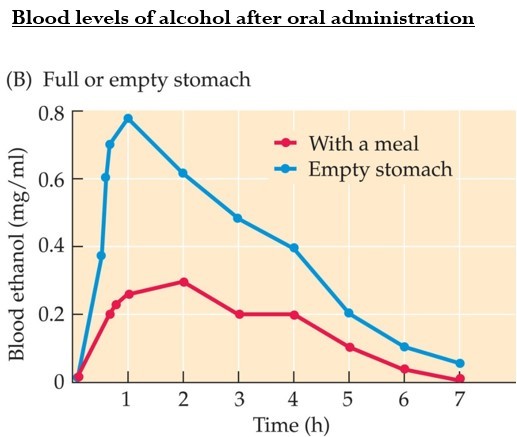
- Many factors influence blood levels of ethanol; thus behavioral effects are described on the basis of blood alcohol concentration (BAC) rather than the amount ingested.
- A 12 oz. can of beer, one 5 oz. glass of wine, a cocktail with 1.5 oz. of spirits, or a 12 oz. wine cooler, will each raise your BAC by the same amount.
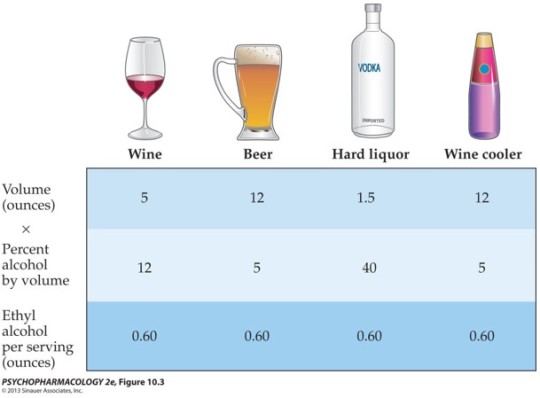
Pharmacokinetics of Alcohol: Distribution
- Ethanol moves by passive diffusion from the higher concentration in the blood to all tissues and fluid compartments.
- Alcohol readily crosses cell membranes, including the blood-brain barrier.
- The same amount of alcohol is more concentrated in the average woman than in the average man because her fluid volume is much smaller.
Pharmacokinetics of Alcohol: Metabolism
- About 95% is metabolized by the liver.
- The remaining 5% is excreted by the lungs and can be measured using a breathalyzer. BAC can then be calculated.
- Alcohol dehydrogenase converts alcohol to acetaldehyde, which is then converted to acetic acid by acetaldehyde dehydrogenase (ALDH).
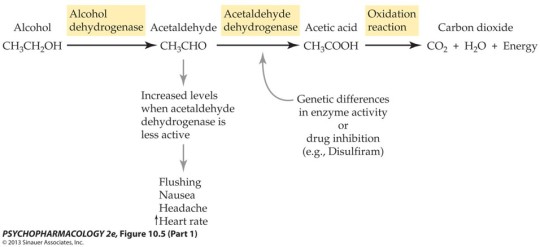
- Interindividual differences: Some people have genes that code for an inactive form of ALDH. Drinking alcohol results in build-up of toxic acetaldehyde, causing flushing, nausea and vomiting, tachycardia, headache, dizziness, etc.
{note: I have this and it’s why I don’t drink. Just not fun for me!}
- Gender differences: Alcohol dehydrogenase in gastric fluid is about 60% more active in men than in women, leaving a higher concentration of alcohol that will be absorbed more rapidly in women.
- Enzymes in the cytochrome P450 family also convert alcohol to acetaldehyde.
- The cytochrome P450 enzymes metabolize many other drugs also.
- It’s dangerous to mix alcohol and sedatives (such as Valium) since they compete for cytochrome P450.
- Prescription and OTC drugs have warning labels regarding alcohol consumption with the drug.
Pharmacodynamics: Behavioral Effects of Alcohol
- defined by BAC
- However, there is a strong placebo effect:
Effects of alcohol can be influenced by an individual’s environment and expectations.
In our culture, it is expected that alcohol will increase sociability, reduce anxiety and tension, increase aggression, and enhance sexual responses.
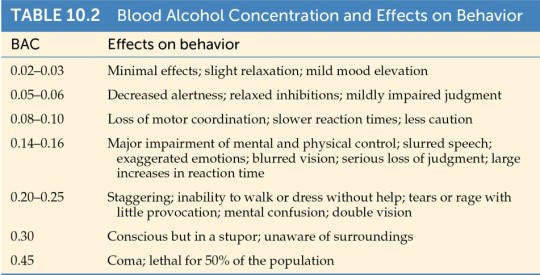
(A) Self-control/Social behavior:
- At low doses, alcohol can result in relaxation and less anxiety.
- In a group, reduced social inhibition may make an individual more gregarious, talkative, and friendly...or inappropriately outspoken.
- Reduced judgment and overconfidence may increase risk-taking behaviors.
(B) Memory function:
- Acute effects on memory vary with dose and task difficulty.
- At high doses, some people experience blackout - total amnesia for events that occur during intoxication.
(C) Motor skills:
- Reduced coordination and impaired motor skills, delayed reaction time, increased drowsiness, all contribute to the increased probability of being involved in automobile accidents.
- There is a distinct temporal pattern of high-risk alcohol-related deaths.
- All states have changed their blood level for legal intoxication from 0.10% to 0.08%.

Pharmacodynamics: Alcohol Poisoning
- Most people do not reach lethal blood levels. At about 0.15%, vomiting may occur; 0.35% usually causes unconsciousness, preventing further drinking.
- If alcohol is consumed rapidly, lethal blood levels may be reached before the individual passes out.
- Symptoms of alcohol poisoning include unconsciousness, vomiting, slow and irregular breathing, and cold, clammy, bluish skin.
- Death results from depression of the respiratory control center in the brain.
- no antidote
{note: you can have your stomach pumped if someone gets you to the hospital quickly enough.}
Neurochemical Effects of Alcohol: GABA (inhibitory)
- stimulates GABA receptors
- binds to GABA (A) receptors and opens the channels, allowing Cl- to enter the cell to hyperpolarize the membrane
- it also stimulates GABA release
- dangerous to combine sedative-hypnotics with benzodiazepines; double inhibitory effect leads to coma and death
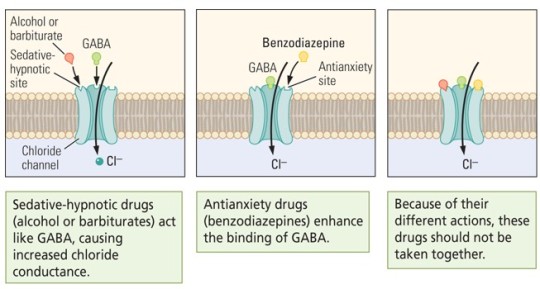
Neurochemical Effects of Alcohol: Glutamate (excitatory)
- Alcohol inhibits NMDA receptors (excitatory glutamate receptors responsible for memory function).
- In addition, it reduces glutamate release in many brain areas, including the hippocampus.
- This is why alcohol affects learning and memory.
Neurochemical Effects of Alcohol: Dopamine
- Alcohol enhances dopamine response in NAcc.
- Inhibition of inhibitory neurons in the VTA ---> disinhibition and activation of the neurons projecting to the NAcc ---> increase in dopaminergic transmission in the mesolimbic pathway
- The dopaminergic mesolimbic system plays a significant role in reinforcement and motivational mechanisms ---> addiction

Neurochemical Effects of Alcohol: Endogenous Opioids
- Opioids (endorphins) attach to the receptors in the brain and produce “opioid effect” which blocks pain, slows breathing, and has a general calming and anti-depressant effect.
- Opioids also contribute to the reinforcing effects of alcohol.
- Acute administration of alcohol increases endogenous opioid (endorphin and enkephalin) production and release.

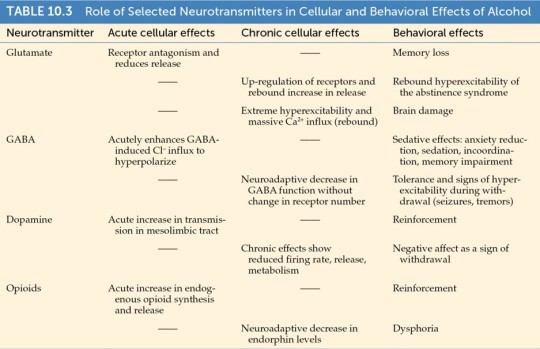
Brain Damage
- Brain damage that occurs after many years of heavy alcohol consumption is caused by the alcohol, elevated acetaldehyde, liver deficiency, and inadequate nutrition.
- Deficiency of thiamine (vitamin B1), which is critical for brain glucose metabolism, causes cell death.
Korsakoff’s Syndrome
- accompanies chronic alcoholism
- permanent loss of the ability to learn new information (anterograde amnesia) and to retrieve recent information (retrograde amnesia)
- In later stages, the patient remembers the distant past, but almost nothing of what goes on around them.
- caused by thalamic damage from chronic alcoholism or malnutrition that produces a vitamin B1 deficiency
- Thiamine treatment can stop the degeneration, but not reverse it.
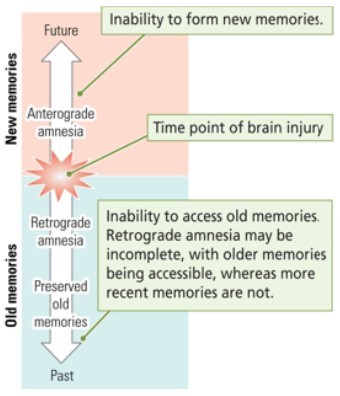
- Other brain areas show cell loss that seems to be unrelated to diet.
- Brain tissue shrinks and ventricles enlarge.

Alcohol: Bodily Effects
- Dilation of peripheral blood vessels causes flushing and feeling warm, but it actually results in the body losing heat.
- Vasodilation in the brain may improve cognitive function in older adults.
- A low to moderate daily dose of alcohol may reduce risk of heart disease; it increases the amount of “good” cholesterol in the blood while reducing the “bad”, and it seems to reduce the incidence of blood clots and stroke.
- However, these beneficial effects are counteracted when consumption increases.
- Heavy alcohol use can impact the GI tract and liver.
- Fatty liver: triglycerides accumulate in liver cells. Alcohol is metabolized first, leaving the fats for storage.
- Alcoholic hepatitis: liver cell damage caused by accumulation of high levels of acetaldehyde.
- Alcoholic cirrhosis: death of liver cells stimulates scar formation and blood vessels carrying oxygen are cut off.
Fetal alcohol syndrome
- Alcohol readily passes through the placental barrier and the fetus quickly reaches the same BAC as the mother.
- Fetal alcohol syndrome (FAS) refers to the damaging developmental effects of prenatal alcohol exposure.
- FAS symptoms include:
Intellectual disability and other developmental delays
Low birth weight; failure to thrive and grow
Distinctive craniofacial malformations
Other physical abnormalities, such as cardiac defects, failure of kidney development, undescended testes, and skeletal abnormalities in fingers and toes
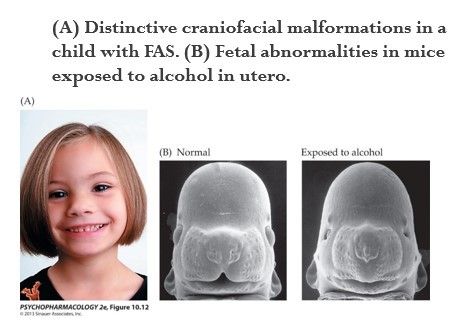
Chronic Use of Alcohol
Metabolic tolerance: increase in P450 liver microsomal enzymes that metabolize the alcohol.
Pharmacodynamic tolerance
Behavioral tolerance
Cross-tolerance with other drugs in the sedative-hypnotic class, including barbiturates & benzodiazepine
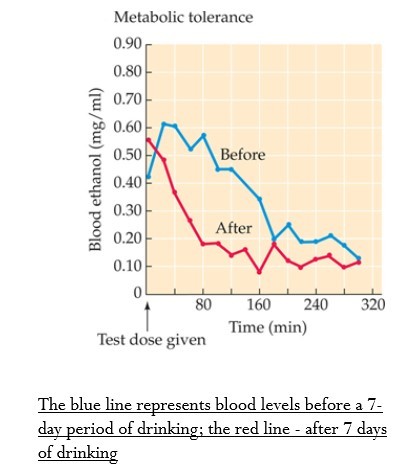
- Prolonged use of alcohol produces physical dependence.
- The intensity and duration of withdrawal signs are dependent on the amount and duration of drug use.
- Alcohol shows cross-dependence with other drugs in the sedative-hypnotic class, including barbiturates and benzodiazepines.
- Withdrawal signs can be eliminated by taking the drug again or by taking any drug in the same class that shows cross-dependence.
- “Hangovers” may be evidence of withdrawal, or a sign of acute toxicity.
- They may result from residual acetaldehyde in the body, alcohol-induced stomach irritation, drop in blood sugar, excess fluid loss, or toxic effects from by-products of fermentation and distillation.
- Symptoms include tremor (the “shakes”), anxiety, high blood pressure, rapid heart rate, sweating, rapid breathing, nausea, and vomiting.
- Some alcoholics experience delirium tremens (DTs) which can include convulsions, hallucinations, disorientation, panic attacks, unstable blood pressure, etc.
Alcoholism: a complex phenomenon with psychological, neurobiological, genetic, and sociocultural factors, making it difficult to define and treat.
Genetic factors: Close relatives of alcoholics have a 3x-7x greater risk for alcoholism than the general population.
In defining alcoholism, the frequency and pattern of alcohol use are as significant as the total amount consumed.
Binge drinking is defined as drinking five drinks in a row.
DSM-5: anyone meeting any two of the 11 criteria during the same 12-month period would receive a diagnosis of alcohol use disorder.
DSM-5 Alcohol Withdrawal Symptoms:
Insomnia (trouble sleeping)
Autonomic symptoms (sweating or racing heart)
Increased hand tremors (”the shakes”)
Nausea and/or vomiting
Psychomotor agitation (feeling physically restless, inability to stop moving)
Anxiety
Seizures (typically generalized tonic-clonic type, which is characterized by rhythmic yet jerking movements, especially of the limbs)
Hallucinations, or perceptual disturbances of the auditory, tactile, and/or visual type (the rarest symptom of alcohol withdrawal)
Treatment of Alcoholism
- The first hurdle is denial; alcoholics often fail to recognize that alcohol is the source of their problems and not the cure.
- Family and friends may act as enablers - repairing the damage caused by the drinker and making excuses for their behavior.
- Psycho-social rehabilitation programs help the alcoholic to prevent relapse:
Individual and group therapy
Residential alcohol-free treatment settings
Self-help groups such as Alcoholics Anonymous (AA)
Pharmacotherapeutic treatment includes two strategies:
(A) Reducing withdrawal symptoms (reducing negative reinforcement)
- During detoxification, painful withdrawal symptoms occur. Drugs that work similar to alcohol can help to reduce those symptoms (ex. benzodiazepines, such as diazepam/Valium).
(B) Reducing alcohol’s positive reinforcing qualities
- Disulfiram (Antabuse) inhibits ALDH (converts acetaldehyde to acetic acid in the normal metabolism of alcohol). Result: drinking even 1 oz of alcohol results in flushing, pounding heart, nausea, vomiting, etc.
- Naltrexone (Vivitrol) is an opioid receptor antagonist; it reduces alcohol consumption and craving and improves abstinence rates. It is assumed that naltrexone reduces the positive feelings and subjective “high” by blocking the effects of alcohol-induced endorphin release.
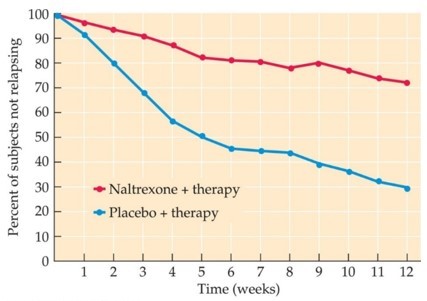
4 notes
·
View notes
Text
'Meth-Prescribed' Long Island Mother Who Killed Child In Wrong-Way Crash Has License Suspended For 57th Time, Denied Bail

During her arraignment on Wednesday afternoon, prosecutors revealed that a mother from Long Island who is accused of killing her young son in a wrong-way crash while “high on methamphetamines” has now had her license revoked for the 57th time.
Following Kerri Bedrick’s arraignment, in which she entered a not guilty plea to murder charges, Suffolk County Judge Richard I. Horowitz ruled that the 32-year-old’s driver’s license would be suspended until the case was resolved and detained her without bond privilege.
When Bedrick drove the wrong way on the Southern State Parkway at 2:15 a.m. on August 22nd, causing a four-car collision that killed her 9-year-old son, investigators stated that her license had already been revoked 56 times, making this the 57th.
When a deputy sheriff first saw Bedrick driving the wrong way, he attempted to pull her over, but she accelerated faster and drove around the deputy’s car, according to the prosecutors.
As she hit 100 miles per hour into oncoming traffic in eastbound lanes, the deputy followed her for more than five miles in a westbound lane from a safe distance, according to the prosecution. Eventually, according to the district attorney’s office, Bedrick’s car hit other vehicles so hard that her engine launched into the woods.
Eli D. Henrys, her 9-year-old son, was discovered unconscious in the 2022 Mitsubishi Eclipse’s backseat. He subsequently passed away from his wounds in the hospital.
Prosecutors claim that after the crash, authorities discovered a prescription bottle inside the defendant’s car with the label ripped off, “seemingly proving” she was under the influence when the defendant went on her driving rampage.
Last month, Suffolk Assistant District Attorney, Laura Newcombe, claimed that the driver allegedly told police that the night before the fatal collision, at around 8 p.m., she had taken methamphetamines. However, her lawyer claims that she was prescribed them. It is unclear if he was referring to the drugs Desoxyn, Adderall, or something else. Drugs of that nature typically treat individuals who suffer from Attention-deficit/hyperactivity disorder (ADHD) or narcolepsy.
She is charged with murder as well as manslaughter, aggravated vehicular homicide, and other connected offenses, such as aggravated unlicensed operation of a motor vehicle.
Prior to the collision, Bedrick’s license had already been suspended 56 times on eight separate days. On Wednesday, she received yet another suspension. State law also permits a driver to receive several suspensions in a single day for a variety of reasons.
The several charges, according to Suffolk County District Attorney Raymond Tierney, show “the severe nature” of the crime, which he also described as a “heinous act.”
“The loss of life in this incident, particularly that of a young child, is heartbreaking,” Tierney said in a statement.
Meanwhile, Bedrick’s attorney, Scott Zerner, labeled the incident a “tragic accident.”
“No one on this planet is more upset about it than she is,” he told reporters. “She suffers from ailments and has been prescribed the methamphetamine properly by a doctor, and she was not under [the] influence of any alcohol or any non-prescription drug that she was not prescribed.”
After the crash, while Bedrick’s son was being rushed to the hospital, she and the other two drivers received medical attention for their injuries.
The negligent mother, whose next court appointment is October 22nd, faces a maximum sentence of 25 years to life in prison if proven guilty of the top count. She is being held without bail.
The deceased boy’s grandmother, Diane Bedrick, has set up a GoFundMe to pay for his funeral costs.
“We have asked for help with Eli’s funeral expenses here. But also if you prefer Eli and his Mom loved to foster animals from the shelter. Donations can also be made to your local shelter or wildlife refuge,” the grandmother posted.
Kerri Bedrick pleaded not guilty and faces 25 years to life in prison she is accused of driving in the wrong direction high on drugs on Long Island and killing her nine year old son. The story @1010WINS. pic.twitter.com/kDFdvyyRDT— sophia_b_hall (@sophiabhall1) September 4, 2024
Kerri Bedrick, charged in a wrong way crash that killed her 9-year-old son, is taken by state Police into custody on charges of driving while impaired by drugs pic.twitter.com/uH6RGMySRM— John Asbury (@JohnAsbury) August 22, 2024
Stay informed! Receive breaking news blasts directly to your inbox for free. Subscribe here. https://www.oann.com/alerts
0 notes
Text
Meth Overdose: Signs, Symptoms, and Treatment Options
Written by:
Leah K. Walker, Ph.D., L.M.F.T.
Edited by:
Wendy Manwarren Generes
Reviewed by:
Kristen Fuller, MD
Updated Jul 19, 2024
3 min read · 5 sections
Evidence-Based Care
Expert Staff
Outpatient Options
Our Services
Methamphetamine is a powerful, highly addictive stimulant drug that affects the central nervous system (CNS).1 Meth increases the activity of several neurotransmitters, including dopamine, a brain chemical important for motivation and the reinforcement of rewarding behaviors.1
Individuals who use meth report feeling a euphoric “rush,” an intense pleasurable feeling that only lasts a couple of minutes, then fades as quickly as it started. Thus, individuals use repeat doses to maintain the high.1
Similar to other substances, taking too much meth, using it in combination with other substances, or ingesting adulterated meth can result in an increased risk of toxicity or fatal overdose.2
In 2021, nearly 33,000 deaths in the United States involved meth.3 Between 2015 and 2019, the number of methamphetamine-related overdose deaths nearly tripled among U.S. adults aged 18 to 64.2
Read this page to learn more about the signs of a meth overdose, what to do if someone overdoses on meth, and where to get help for meth addiction.
What Is Meth?
Methamphetamine, colloquially referred to as meth, is classified as a Schedule II drug by the U.S. Drug Enforcement Administration (DEA), which means it has a high potential for dependence and addiction.4 In 2021, 2.5 million Americans aged 12 or older reported using methamphetamine within the past year. Additionally, an estimated 1.6 million individuals aged 12 or older in the U.S. met the criteria for a methamphetamine use disorder in 2021.5
Though legally available by prescription as Desoxyn—a drug with very limited use for the treatment of attention deficit hyperactivity disorder (ADHD) and obesity—most methamphetamine used in the United States is produced and distributed illicitly and used recreationally.6
When a person uses meth, they experience increased alertness and physical activity, decreased appetite, and an elevated mood.6 However, chronic recreational meth use can lead to a host of health consequences, including but not limited to aggression, mood swings, cognitive problems, severe tooth decay, weight loss and malnutrition, paranoia, and hallucinations.1
Take Our Substance Use Self-Assessment
Take our free, 5-minute substance use self-assessment below if you think you or someone you love might be struggling with substance use. The evaluation consists of 11 yes or no questions that are intended to be used as an informational tool to assess the severity and probability of a substance use disorder. The test is free, confidential, and no personal information is needed to receive the result.
0 notes
Text
Medical Uses of Illicit Drugs: An Examination
The internet has revolutionized many aspects of life, including the way people access medications and substances. This article delves into the potential medical uses and implications of various substances that can be purchased online, albeit often illegally. Specifically, we will explore crystal meth, crack cocaine, Colombian cocaine, marijuana, Trainwreck, alprazolam powder, and Ozempic sourced from Mexico.

Crystal Meth
Crystal methamphetamine, commonly known as crystal meth, is a potent stimulant that affects the central nervous system. While its abuse is well-documented and associated with severe health risks, methamphetamine does have legitimate medical uses.
Medically, methamphetamine is used in the treatment of attention deficit hyperactivity disorder (ADHD) and certain cases of obesity. Marketed under the brand name Desoxyn, it is prescribed in much lower doses than those typically abused. The medication works by increasing the release of dopamine and norepinephrine in the brain, which helps improve focus and reduce impulsive behaviors in ADHD patients. For obesity, it is used as a short-term adjunct in a regimen of weight reduction based on caloric restriction.
Crack Cocaine and Colombian Cocaine
Crack cocaine and powdered cocaine, including varieties such as Colombian cocaine, are notorious for their high potential for abuse and addiction. However, they have historical and limited contemporary medical uses.
Cocaine is an effective local anesthetic and vasoconstrictor. It is still used in some medical procedures, particularly in otolaryngology (ear, nose, and throat surgeries) and ophthalmology (eye surgeries). Cocaine's ability to numb tissue and reduce bleeding makes it useful in these specialized surgical contexts. However, due to its high potential for abuse and the availability of safer alternatives, its use is tightly controlled and very limited.
Marijuana
Marijuana, or cannabis, has been used medicinally for thousands of years. With the growing legalization movement, its medical uses have come under rigorous scientific scrutiny.
Medical marijuana is used to treat a variety of conditions, including chronic pain, nausea and vomiting associated with chemotherapy, multiple sclerosis spasticity, and epilepsy. Cannabinoids, the active compounds in marijuana, interact with the body's endocannabinoid system to produce therapeutic effects. For example, THC (tetrahydrocannabinol) can help reduce pain and stimulate appetite, while CBD (cannabidiol) is known for its anti-inflammatory and anti-anxiety properties.
The strain known as Trainwreck, a hybrid cannabis strain, is particularly noted for its high THC content, which can be effective in managing severe pain and reducing symptoms of PTSD and anxiety.
Alprazolam Powder
Alprazolam, commonly known by its brand name Xanax, is a medication primarily used to treat anxiety and panic disorders. It belongs to the benzodiazepine class, which works by enhancing the effects of the neurotransmitter GABA in the brain, producing a calming effect.
In powdered form, alprazolam is used in pharmaceutical manufacturing but is also sought after illicitly due to its high potential for abuse and addiction. Medically, alprazolam is valuable for its rapid onset of action, which can provide quick relief for acute anxiety episodes. However, it must be used under strict medical supervision to avoid dependency and adverse effects.
Ozempic Sourced Online from Mexico
Ozempic (semaglutide) is a medication used for managing type 2 diabetes and, more recently, for weight loss. It is a GLP-1 receptor agonist that helps regulate blood sugar levels by stimulating insulin secretion and reducing glucagon release. It also slows gastric emptying, which can contribute to weight loss by promoting a feeling of fullness.
While Ozempic is a prescription medication in the United States, some individuals seek to purchase it online from countries like Mexico, where it may be available without a prescription and at a lower cost. However, this practice carries significant risks, including the potential for receiving counterfeit or unsafe medications, and the lack of professional medical guidance in its use.
Risks and Ethical Considerations
While the substances discussed can have legitimate medical uses, purchasing them online, especially from unregulated sources, poses significant risks. The quality, purity, and dosage of such substances cannot be guaranteed, leading to potentially dangerous consequences. Furthermore, self-medicating with these powerful drugs without proper medical supervision can result in severe health issues, addiction, and even death.
Ethically, the promotion of online sales of such substances can contribute to the broader issues of drug abuse and addiction in society. It is crucial for healthcare professionals, policymakers, and the public to focus on safe, regulated, and evidence-based approaches to using these substances for medical purposes.
The medical uses of substances like crystal meth, cocaine, marijuana, alprazolam, and Ozempic underscore the complex relationship between their therapeutic potential and their risks of abuse and dependency. While these drugs can offer significant benefits when used correctly and under medical supervision, the dangers of illicit online purchasing cannot be overstated. As the landscape of drug accessibility continues to evolve, it is imperative to prioritize safety, regulation, and education to ensure these powerful medications are used responsibly and effectively.
For more information, please visit us at :
Buy Crystal Meth Online
Buying Crystal Meth Online
Buy Crystal Meth
Crystal Meth For Sale Online
Pure Cocaine Online For Sale In Uk
Crystal Meth For Sale Australia
Where Can I Buy Crystal Meth
Crack Cocaine For Sale Online
Cheap Cocaine Online
Buy Crack Cocaine Online
Buy Colombian Cocaine
Buy Weed Marijuana Trainwreck Online
1 note
·
View note
Text
I really love sharing that meth is still a prescription medication and its brand name is desoxyn, one of my fav fun facts to toss out there
#meat.txt#...obvs it taken at lower doses than what youd see recreationally#5-45mg orally is the medical dose iirc
0 notes
Text
The History of Meth in the United States

Methamphetamine, often referred to as "meth" or "crystal meth," has had a long and tumultuous history in the United States. Initially used for legitimate medical and industrial purposes, the drug has since shifted to illicit uses and become one of the most serious drug crises in the country. In this article by Banyan Treatment Center, we explore the history of this drug in the United States, from its original medical applications in World War II to its illegal exploitation by organized crime in later decades. Let's take a look at some key points:
Methamphetamine was first synthesized in 1919, becoming an immediately popular drug in Japan by the 1930s.
It eventually reached the United States in the 1950s, in the form of prescription drugs such as Desoxyn and Methedrine.
By the 1970s, methamphetamine was being made illicitly in the U.S., with clandestine laboratories springing up throughout the country.
In the 1990s, the drug's popularity skyrocketed. Crystal meth attracted a variety of people, from laborers to partygoers, and it became widely available and affordable. However, the drug's harmful effects soon took their toll. In 2004, the Methamphetamine Contaminated Property Remediation Act was passed, allowing the federal government to go after people using the drug. Since then, many states have implemented strict controls on methamphetamine manufacturing and use. Still, the problem persists, with more people than ever before experimenting with the hazardous drug. To learn more about methamphetamine's history, check out the full article here.
0 notes
Text
the final boss of the medical industrial complex is acquiring a legal, insurance-authorized prescription for Desoxyn (methamphetamine hydrochloride). i think i could do it if i had the same doctor for a few years and really tried
28 notes
·
View notes
Text
Buy desoxyn online usa
Buy desoxyn online usa – Methamphetamine Hydrochlorlde

What is Desoxyn?
Desoxyn is a professionally prescribed medicine affirmed for treating ADHD and heftiness. In any case, it is likewise a regularly mishandled drug.
We have been in this business for a long time. We offer Desoxyn, best case scenario rates. Since Desoxyn is a controlled
substance, there are progressively prohibitive guidelines concerning how it might be acquired than there are for most different kinds of
professionally prescribed medications. Likewise, there are severe fines and punishments for utilizing or attempting to get it without a
medicine.
In any case, we have the best and most secure approaches to ship and exchange with Desoxyn round the world.
Where to purchase Desoxyn online
Desoxyn can be gotten without a medicine, we offer Desoxyn without a solution.
0 notes
Text
Today is the day I learned that you can absolutely get 100% pure methamphetamine salts (crystal meth) by prescription (as Desoxyn).Today is also the day I inquired about Desoxyn lmao
(ノ*・ω・)ノ
I've yet to be offered literal meth, but I'm on max dose Adderall and feeling tolerance. There’s probably significant cross tolerance since amphetamine salts (Adderall) is literally just demethylated methamphetamine salts (Deosxyn/desired active ingredient in crystal meth -- see image below) especially considering Adderall has cross-tolerance with Ritalin, which is a completely different kind of drug, despite both being stimulants and having some common end targets. But if the methylated version is stronger, maybe it will work better than Adderall?

So I mean I do expect to see cross tolerance there, like I expect to see cross tolerance with benzodiazepines for instance -- where they’re all essentially the same thing in slightly different packaging:

but Adderall and Ritalin probably don’t even belong in the same class if we’re looking at a taxonomy based on chemical structure. They’re both CNS stimulants, but totally different:

Ritalin activates D1 and D2 dopamine receptors, as far as I understand Adderall has a broader range of actions on dopamine and norepinephrine receptors and also binds to epinephrine receptors in the adrenal glands. D1 and D2 are probably common targets, though. (Turns out the exact receptors that Adderall binds to and with what affinity is kind of a tricky topic?)
Also, fun fact: amphetamines are very similar to compounds that occur naturally inside our bodies (endogenous compounds), albeit these typically occur in trace amounts.
#psychiatry#personal#medication#special interest#actually autistic#actuallyautistic#actually adhd#actuallyadhd#adhd#adderall#ritalin#drugs#pharmacology#psychopharmacology
35 notes
·
View notes